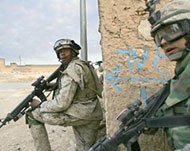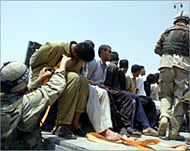Rumsfeld defends Iraq force size
US Defence Secretary Donald Rumsfeld has voiced exasperation over criticism that the US committed too few troops to stabilise Iraq against the advice of his former army chief of staff.

Rumsfeld on Wednesdsay said his top commanders recommended that the smaller sized force be used in Iraq, and that was the number of troops the administration went with.
“So I must say I am tired of the Shinseki argument being bandied about day after day in the press,” Rumsfeld told members of the Senate Appropriations Committee.
General Eric Shinseki was the army chief of staff who told Congress before the US-led invasion of Iraq two years ago that about the same number of troops would be needed to stabilise Iraq as to invade – several hundred thousand, by his estimate.
His warning was dismissed at the time by Rumsfeld and Deputy Defence Secretary Paul Wolfowitz, deepening Shinseki’s estrangement from the Pentagon’s civilian leadership.
Disadvantages
 |
|
Some say there were not enough |
Some critics, including retired generals and other experts, have blamed the rise of the insurgency on the Pentagon’s failure to deploy enough troops to quickly secure the country after the invasion.
Looting and lawlessness swept Baghdad and other parts of the country after the fall of the regime of Saddam Hussein, often as US forces stood by.
But Rumsfeld said that in deciding on the size of the force, the commanders had to weigh the disadvantages of fielding a large occupation force.
“And the tension that they have balanced is this: The more troops you have, the more targets you have and the more people you might get killed,” he said.
“The more troops you have, the more of an occupying power you are. The heavier the footprint, the more force protection you need, the more logistics you need and the more intrusive you are on the people of that country,” he said.
“Now, the Soviets had 300,000 people in Afghanistan, and they lost. And we had 20,000 or 30,000 people in Afghanistan, and it’s coming out pretty darn well,” he said.
General’s idea
 |
|
Looting and lawlessness swept |
Rumsfeld said the number of troops decided for the Iraq invasion was proposed by General Tommy Franks, the US commander in the region; General John Abizaid, the deputy commander and now top commander; General Richard Myers, the chairman of the Joint Chiefs of Staff; and General Peter Pace, the vice chairman and Rumsfeld’s choice to replace Myers.
At one point in the hearing, Rumsfeld turned to Myers to back him up.
Myers said that before the invasion, President George Bush asked all the service chiefs at a meeting whether they had all they needed, and put the same question to Franks and his commanders at a separate meeting.
Asked whether Shinseki remained silent when the question was asked, Myers said he could not remember.
“He certainly didn’t bring up a couple of hundred thousand,” Myers said.
“We were all very – all of the service chiefs were in total support of General Franks’ plan, the numbers that we had planned, all of that. Yes, we were all on board. There were no outlyers,” he said.